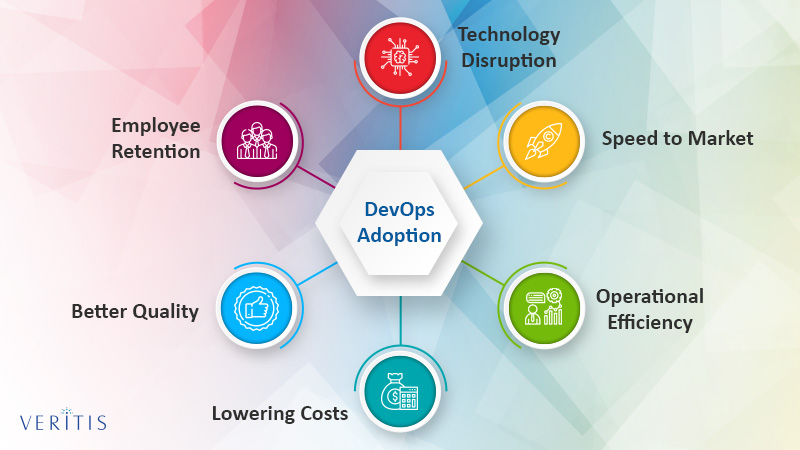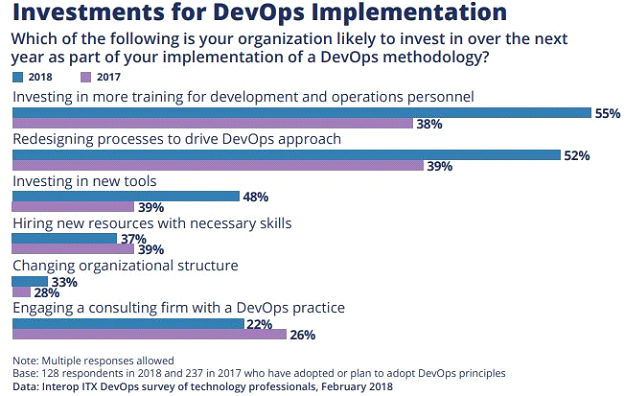
Growing consumer demand for more products and smart applications that ease processes has really changed the pace of the IT industry. This has resulted in growing competition among firms to adopt the right technology solutions that can offer them a competitive edge in the market.
Many such solutions have arrived over the years, but one technology trend has become a buzzword across firms over the past couple of years—it’s DevOps!
More than a technology, firms adopting that technology love to call it a culture as it’s the trend that reinvented collaboration between the two key teams of any organization: developers (Dev) and Operations (Ops).
Moreover, technology has been most sought as a one-stop solution for achieving continuous and quality product delivery, faster recovery time and innovation, and most importantly, all in a collaborative environment.
DevOps Adoption Strategy

Four adoption paths best describe an organization’s path to success right from being Inefficient to becoming Leaner in the second stage and Smarter finally:
- Steer Inefficiency: This is the first stage of transition that defines companies’ success through DevOps adoption. At this stage, the organization transforms from process-based to product-based and finally becomes intelligent enough to optimize its processes for further efficiency.
- Develop/Test: The next stage after transformation to a product-based approach is to accelerate the development process and adopt agile methodologies to test. This forms the second stage of transition after DevOps adoption.
- Deploy: Once the pace of development is achieved, the next stage is to make it faster and smarter, which is where Automation steps in. Automation forms the third stage on the path to success through DevOps adoption. Automate the process for transparency, quick release, and ease of further deployment.
- Operate: At this stage of DevOps, the organizations start moving away from being siloed to becoming collaborative.
These four stages form the clear-cut DevOps strategy that has made DevOps deployers (organizations) smart enough to deal with the entire software process chain to gain a competitive edge over their competitors.
Mentioned below are the factors that influence DevOps Adoption

- Speed to Market – The world industries are running at mad speed to fulfill the needs of customers alongside keeping their foot stable in the face of competition. Resultant, business owners are looking at solutions that can help them do both. Therefore, DevOps is turning out to be an efficient and reliable solution for leveraging business operations while surpassing industry expectations.
- Operational Efficiency – Organizations are beginning to see the speed at which software is deployed and internal application errors are fixed. The enhanced workflow has led business owners to believe in the potential of DevOps.
- Lowering Costs – Companies have minimized wasteful expenditure on recruiting people with limited or No DevOps knowledge and on maintaining unnecessary tools and resources. This drives the ‘company spends’on the most important things. The cost factor is the key influencer in the DevOps adoption.
- Better Quality – Bugs don’t disrupt occur, workflows generate the desired results and applications respond in no time to fulfill your request. What more! The quality of work and reliability of applications have made key business stakeholders to realize the power of DevOps.
- Employee Retention – With the dawn of the DevOps concept, employers have begun to realize that they don’t require new staff or people with given knowledge rather their existing workforce is enough to chalk out a successful DevOps plan. This trend has made business owners retain their ‘cream of the crop’.
- Technology Disruption – Technology malfunctioning can throw your business prospects out of gear. With the DevOps system in place and the systematic approach of coding, testing and deployment, you know that your technology can never disappoint you. Not everyone is in to deal with downtime.
Now, we will see the real-time impact of the DevOps technology and the resultant DevOps market demand that changed the IT scenario, finally emerging as a DevOps trend.
DevOps Market Scenario
The demand for DevOps has grown over the last three years (2016-18).

Let’s take a look at some of the critical research that recorded the status of DevOps adoption trend over the period:
- A 2016 State of the Cloud Report reported a 74 percent DevOps adoption rate in 2016, compared to 66 percent in 2015. Demand is high both among large enterprises and Small-Scale Businesses (SMBs); while it was 81 percent in the case of large enterprises, it is 70 percent in the case of SMBs, with Puppet, Chef, Docker, Ansible, Salt, and Rocket among the DevOps tools most sought in the order.
- 2016 State of DevOps Report: The survey reported a rise in DevOps teams across organizations from 2014 to 2016, from 16 percent in 2014 to 19 percent in 2015 and 22 percent by 2016. Region-wise, North America reported a 53 percent rise in the DevOps trend, followed by Europe and Russia (26 percent) and Asia (10 percent), among others.
- 2017 State of DevOps Report: The survey reported a rise in DevOps adoption rate to 28 percent from 22 percent in 2016. The survey concluded that this rise indicated firms’ willingness to adopt a DevOps strategy and complete the transition to DevOps from old practices. 2017 also saw a rise in the DevOps trend, region-wise, compared to 2016. North America followed by Europe and Russia reported a one percent rise in DevOps adoption trend in 2017 over 2016, however, Asia remained the same.
- 2018 State of DevOps Report: 2018 saw an 18 percent rise in DevOps implementation over the previous year, and 53 percent of the survey reported demand for faster release as the major driver for DevOps adoption. While 60 percent reported fast-paced application development, 80 percent reported faster recovery and ease in maintenance as one of the key DevOps benefits. Docker, Slack, and GitHub emerged as the most popular DevOps tools.
- Industry-wise Trend: The Status of DevOps reports for 2016 and 2017 reported the highest DevOps adoption rate across the Technology industry (34-35 percent), followed by Financial Services (12-14 percent), Retail (7-8 percent) and Telecom (6-7 percent), among others.
- Investment Trend: Key areas of investment considered as part of the DevOps implementation strategy over the 2017-18 period include Training for Dev and Ops teams (38-55 percent), Redesigning the process (39-52 percent), Investing in new tools (39-48 percent), Hiring (37-39 percent), Changing the organization structure (28-33 percent), and Engaging a Consulting Firm (22-26 percent).
In Conclusion
While factors such as deployment automation (66 percent), version control (62 percent), continuous integration (59 percent), and infrastructure automation (57 percent) are the most common starting points for the DevOps journey, aspects such as working in small batches to allow single-piece flow, visualization of important quality and productivity metrics, and setting limits on work in progress are the least common starting points.
Overall, DevOps is no longer just a buzzword!
It has become a culture and integral part of many organizations as a means to improve overall performance, profitability, revenues, and various other key metrics and yield remarkable results.
Also Read: